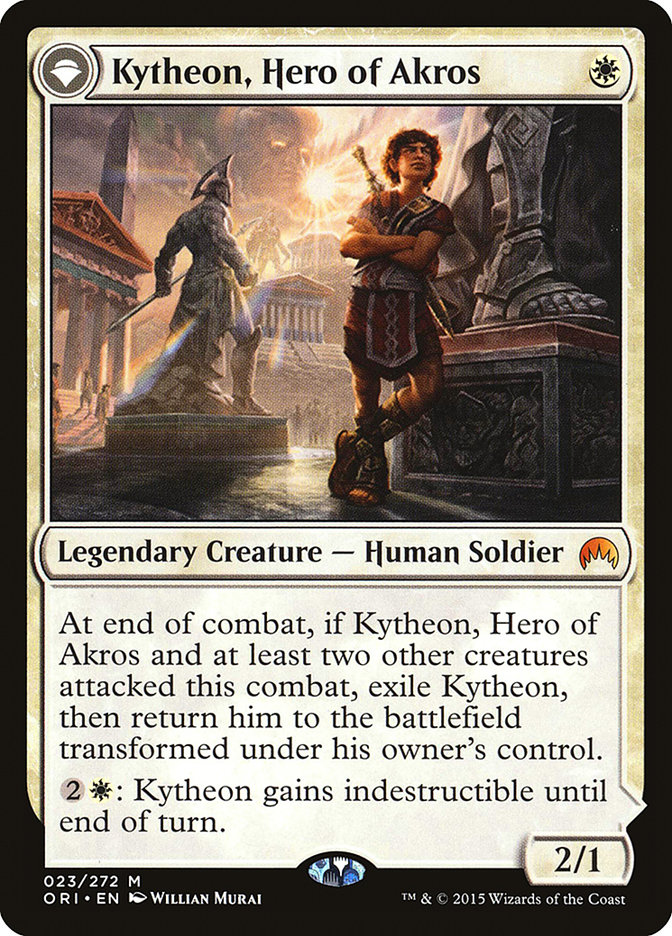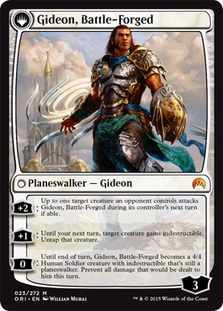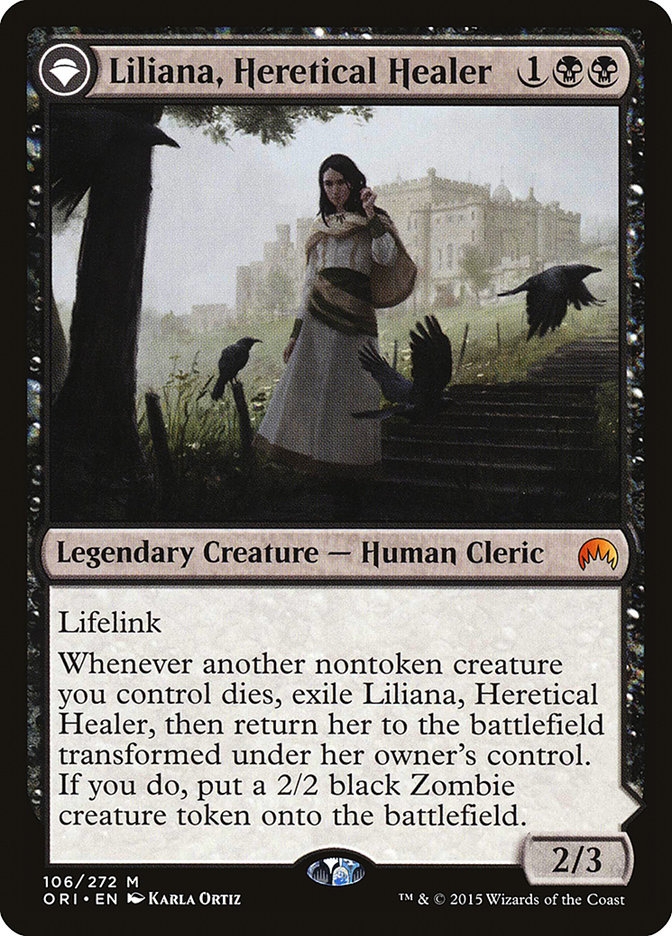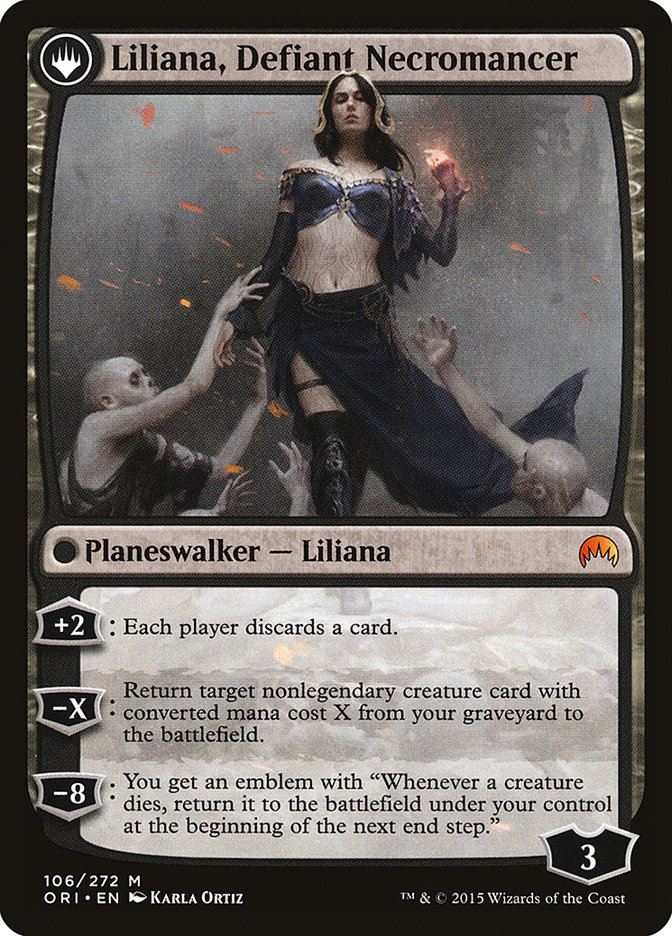Is it just me or does spoiler season seem to come faster these days? Maybe I remember the days when core sets were all reprints so there was little to be excited about over the summer, but now we all have plenty of new cards to pore over and speculate about and Magic Origins is certainly no exception. Recently, part of a cycle of the set’s new planeswalkers was spoiled and they are, to use a pun only Brian Braun-Duin could love, flippin’ sweet. So I will dispense with my typically long introduction and get right to what everyone cares about: campaign finance refor— evaluating cards.
In general with these transform planeswalkers, the intuitive way to evaluate them is to weigh your perception of the card toward the side that is most likely to be face-up over the course of an average game. Of course you can warp your deck to be able to transform them as quickly and reliably as possible but unless the planeswalker side has an incredible payoff you will generally be better served supporting the creature sides as best you can without making significant power-level sacrifices.
I will admit that when I first looked at this card I was disappointed, but it is now the spoiled card I am most excited about. Obviously the stats on the card are powerful, but part of the excitement of spoiler season is the prospect of evaluating completely new cards and Gideon, Battle-Forged just looked like a toned-down Gideon Jura.
On top of this letdown was the fact that Gideon Jura has always been a defensively-oriented planeswalker while its Battle-Forged counterpart is on the back side of an aggressive staple reminiscent of Savannah Lions. Why would I want to play a worse Gideon Jura outside of its natural home?
As I pondered that question steeped in my own sense of disappointment, I realized that this was not a problem but an interesting challenge. How do we best utilize Gideon in an aggressive shell? As it turns out, Gideon is not as antithetical to aggressive decks as one might assume given how Gideon Jura has been dominating creature decks for years now. The first ability, often used to neutralize opposing attackers, can also be used to tap potential blockers, clearing the way for an attack with the various small creatures Kytheon needs to be surrounded by to transform.
Swarming aggressive decks often fall victim to these sorts of speed bumps since they lack the space to include the removal necessary to clear the way, instead relying on speed and board presence to ignore roadblocks like Courser of Kruphix and Deathmist Raptor. Having a card that functions as a threat on turn one, a bigger threat later in the game, and a way to remove blockers is unprecedented in such decks.
In addition, Kytheon offers insulation against most sweepers on both sides of the card, either with its activated ability protecting itself or Gideon’s +1 ability protecting your best creature –or giving you an indestructible blocker that can protect Gideon. Despite having half the loyalty of Gideon Jura, this new version should be just as difficult to kill without direct removal like Hero’s Downfall, which conveniently rotates a few months after the release of Magic Origins.
Focusing on the current Standard format, I am most excited to try Kytheon in the R/W Aggro shell. R/W was perhaps the best deck in the format immediately following the release of Fate Reforged, but it quickly fell into obscurity for two reasons. The first is that the metagame adjusted to deal with Chained to the Rocks. The second was that the deck did not have the necessary density of powerful early plays to consistently gain initiative and it was quite poor at playing from behind. Kytheon adds another powerful early threat while Valorous Stance and Roast can combine to help replace Chained to the Rocks, leading to the following initial list:
Creatures (19)
- 4 Goblin Rabblemaster
- 4 Wingmate Roc
- 2 Ashcloud Phoenix
- 4 Seeker of the Way
- 1 Soulfire Grand Master
- 4 Kytheon, Hero of Akros
Planeswalkers (2)
Lands (24)
Spells (15)

This R/W Aggro list is more akin to the one Sam Black championed last December, playing it at the 2014 Season Four Invitational in Seattle. Sam was always adamant that the Monastery Swiftspears he used were an unappreciated part of the deck, allowing him to gain important early initiative. Kytheon allows us a means to do that without sacrificing on power level. The token generators that allow us to reliably trigger Raid for Wingmate Roc also help transform Kytheon, and Chandra, Pyromaster gives a redundant effect for clearing blockers.
It is important to note that Kytheon works particularly well with haste, and thus Dash creatures, so it may be prudent to use Goblin Heelcutter over Chandra, Pyromaster, or you could lower the curve and use Zurgo Bellstriker.
If you really want to lower the curve you could look at using Kytheon in a B/W Warriors shell as an additional Savannah Lions. (Seriously, I think Kytheon may be the 30th one-mana 2/1 in Standard — you kids don’t know how good you have it.) Or we can try a Soldier theme with Raise the Alarm, Launch the Fleet, and Obelisk of Urd. A starting decklist for the latter looks like this:
Creatures (21)
- 4 Akroan Crusader
- 4 Favored Hoplite
- 4 Soldier of the Pantheon
- 4 Akroan Hoplite
- 1 Zurgo Bellstriker
- 4 Kytheon, Hero of Akros
Lands (21)
Spells (18)

There is a delicate balance to be played here between having Heroic enablers and Obelisk enablers, but Akroan Crusader being able to turn the one-mana tricks into another Soldier helps to bridge the gap – as does Launch the Fleet, which is excellent in this shell.
As someone who has frequently tried and failed to do some honest attacking in this midrange-dominated format, I am excited to see a cheap creature that can hold its own later in the game. Much like how Warden of the First Tree was a welcome addition to Abzan Aggro, I expect Kytheon to find an easy home in Boros-based decks.
This is the most interesting of the planeswalkers because the creature half guides you down a very specific path in deck construction. Unless you are content with a 2/3 lifelink creature for three mana, you will likely want to put in some work in finding the best sacrifice outlets to pair with the new Liliana.
My favorite by far is Sidisi, Undead Vizier. The exploit mechanic is a great way to transform Liliana because it does not require Liliana to gain a sizable advantage… and the traditional partner of Sidisi, Satyr Wayfinder, provides an easy way to take advantage of the planeswalker side of Liliana and her second ability.
In order to break the symmetry on her +2, we will want to incorporate some graveyard synergies and be able to play games of attrition. All signs point to merging Liliana with the powerful Deathmist Raptor + Den Protector shell, and my opening draft borrows heavily from the old Sultai Reanimator decks:
Creatures (28)
- 1 Hornet Queen
- 3 Sylvan Caryatid
- 3 Courser of Kruphix
- 4 Satyr Wayfinder
- 4 Sidisi, Brood Tyrant
- 1 Torrent Elemental
- 1 Dragonlord Silumgar
- 3 Sidisi, Undead Vizier
- 3 Den Protector
- 3 Deathmist Raptor
- 2 Liliana, Heretical Healer
Lands (24)
Spells (8)

For the most part this is a pretty standard Sultai Reanimator list, but Liliana gives you another angle of attack. This deck does not fully leverage Liliana’s abilities, using them as more tools in a varied arsenal, which is key for midrange decks. The added angle is especially relevant against control decks, where the +2 is a threat by itself, the –X is a source of raw card advantage, and her ultimate is essentially unbeatable.
I personally put down the Sultai Reanimator deck because it was unable to compete simultaneously against both green board presence decks and Esper Dragons, so gaining a powerful threat that can provide long-term card advantage in attrition matchups as well as greatly restricting a control opponent’s resources is a significant gain. It could be that this list does not focus on Liliana enough, but we can always find that out by playing some more with Origins cards – it’s important to try out new things, and we have plenty of time ahead of us to learn how Liliana works in this format.
You could use sacrifice outlets like Tymaret, the Murder King or Butcher of the Horde to make a more aggressive Aristocrats-style list, which would look something like this:
Creatures (24)
- 3 Tymaret, the Murder King
- 4 Goblin Rabblemaster
- 4 Butcher of the Horde
- 4 Bloodsoaked Champion
- 1 Alesha, Who Smiles at Death
- 2 Zurgo Bellstriker
- 2 Blood-Chin Rager
- 4 Liliana, Heretical Healer
Lands (24)
Spells (12)

The cheap creatures in this deck are all Warriors, so Blood-Chin Rager can put in some good work along with our removal to clear away blockers. It also allows us to upgrade Outpost Siege into Raiders’ Spoils in the sideboard, a card that can create a huge swing immediately upon entering the battlefield as well as synergizing nicely with Hordeling Outburst in addition to the many Warriors in the deck. The singleton Alesha is certainly speculative, but it is a powerful effect that plays well with our sacrifice synergies and is a single card can rebuild our board after a sweeper.
We could also focus more on the Warrior theme and use Blood-Chin Fanatic over Butcher as a second sacrifice outlet, perhaps replacing Butcher with Brutal Hordechief. Cutting white means Crackling Doom would have to come out, likely for additional burn such as Lightning Strike. These decks, while featuring creatures that can be easily outclassed in combat, always have plenty of reach and ways to use your mana going long, which is incredibly important for aggressive decks in midrange-dominated formats like this one.
It is also important to note that aggressive decks can frequently be held back early in a format by missing a key piece of their curve, thus reducing their ability to establish early initiative. As new sets are added and the entire curve can be filled by better cards, the aggressive decks gain percentage points across the board in the metagame. I will certainly be looking to attack unprepared midrange opponents who mistakenly think their Coursers and Drown in Sorrows will continue to insulate them against aggressive strategies like they have over the course of the format so far.
With only a few weeks before the release of Magic Origins, I am excited to start thinking about how this set will change Standard. Maybe I am being harsh, but Standard right now feels fairly stale. It is still dynamic in that the metagame is shifting each week, but at this point it is shifting between mostly known and explored decks. Magic Origins should provide a nice late shake-up to what has been an excellent Standard format, and I hope you are looking forward to it as much as I am!




